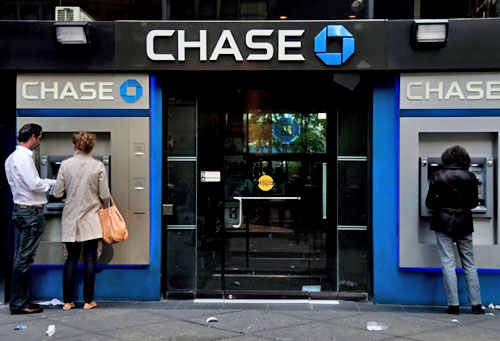
by
Danielle Douglas
September 12,
2012
from
WashingtonPost Website

In this May 6, 2012, photo,
people use Chase ATM machines at a branch in New York.
Americans stepped up their
borrowing in May,
helped by the largest
one-month gain in credit card debt in more than four years.
But overall credit card use
is still well below where it was just before the Great Recession began.
(AP Photo/CX Matiash)
In the
aftermath of one of the worst recessions in history, more
Americans have limited or no interaction with banks, instead
relying on check cashers and payday lenders to manage their
finances, according to a new federal report.
Not only are these Americans more
vulnerable to high fees and interest rates, but they are also
cut off from credit to buy a car or a home or pay for college,
the report from the Federal Deposit Insurance Corp. said.
Released Wednesday, the
study found that 821,000 households opted out of the
banking system from 2009 to 2011 and that the so-called
unbanked population grew to 8.2 percent of U.S.
households.
That means that roughly 17 million adults
are without a checking or savings account. Another 51 million adults
have a bank account, but use pawnshops, payday lenders or rent-to-own
services, the FDIC said.
This underbanked population has grown from 18.2
percent to 20.1 percent of households nationwide.
The study also found that one in four
households, or 28.3 percent, either had one or no bank account. A third
of these households said they do not have enough money to open and fund
an account. Minorities, the unemployed, young people and lower-income
households are least likely to have accounts.
Stubbornly
high unemployment and underemployment have placed millions of
Americans in precarious financial positions, leaving them unable to
absorb overdraft charges or minimum-balance fees.
In the past year alone,
Wells Fargo, Capital One and SunTrust have alerted customers to
pending fee hikes on checking accounts or have raised overdraft charges.
Banks say service charges are needed to offset the loss of revenue from
a cap on debit-card transaction fees imposed by the government.
“Banks need to have pricing and practices
that consumers can trust and allow them to build wealth and have
economic mobility,” said Deborah Goldstein, chief operating officer at
the Center for Responsible Lending.
“If the account fees will leave them
worse off, then its going to be a challenge for people to use banking
services.”
Banks say it is difficult to make money
serving lower-income communities because the cost of managing their
accounts outweighs the return.
“There has to be a recognition that there
are costs to providing accounts and those costs have to be covered,”
said Nessa Feddis, vice president and general counsel at the American
Bankers Association.
She estimated that it costs banks up to $300 a year
to maintain a checking account because of expenses such as processing
transactions.
National Community Reinvestment Coalition
chief executive John Taylor argued that banks could make up some of that
cost by the sheer volume of new accounts.
Feddis disagreed.
“You can’t take a losing
account and make it up in bulk,” she said. “You’re not going to spend
money to lose money.”
Without access to traditional banks, Taylor
said, Americans are susceptible to abusive practices at non-bank
institutions and are likely to remain trapped in a vicious cycle of
financial strain.
“A part of changing the condition of unbanked
people is keeping them away from predatory lenders who keep them mired in
debt,” he said. “One of the reasons you had all of these mortgage companies
preying on low-income communities is because there were no options.”
A
report from SNL Financial in April showed that banks have closed dozens
of branches in neighborhoods with a median household income of $25,000 or
less since 2007, shifting resources to areas where the median income is
$100,000 or more.
“The [Community Reinvestment Act] has had a
significant impact over the last 30 years, but did not contemplate some of
the new abuses that we’re seeing and the way banking has changed,” Goldstein
said.
“But we’ve now seen financial reform that includes additional consumer
protection.”
Congress passed the act in 1977 to address the
shortage of credit available to low- and moderate-income neighborhoods.
Consumer advocates, however, say that regulation has fallen short of
ensuring that banks offer reasonably priced services.
The newly minted Consumer Financial Protection
Bureau has jurisdiction over non-bank institutions and plans to weed out
predatory practices. The agency reviews compliance with federal consumer
financial laws such as the Fair Credit Act.
In the past year, a quarter of households have
used at least one type of alternative financial service, such as a tax
refund anticipation loan or money order, the FDIC study found.
Some
households, 7.5 percent, said they simply did not trust or feel comfortable
dealing with banks. Another 6.6 percent said they could not open accounts
because they lacked required identification or suffered from poor credit.
A growing number of consumers without bank
accounts are turning to prepaid cards, with nearly 18 percent of households,
up from 12 percent in 2009, reporting the use of such products.
Feddis of the banking association said prepaid
cards are an innovative tool that banks could use to serve lower-income
communities without incurring much cost.
“There are fewer ways to access the account, so
there are fewer opportunities for fraud, which banks pay a lot to protect
against,” she said.

